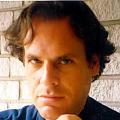
Sharpville is a website started earlier this year as "a meeting place for friends and lovers of Willoughby Sharp". It is open to participation by all: to view or add photos and videos, to participate in the discussion forum or chat room, to share tall tales and innumerable stories, to announce events. The photo above (from 1985) and the video below (from the 2007 restrospective exhibition at Mitchell Algus Gallery) are both taken from the site.
Willoughby passed away early in the morning on Wednesday, December 17, 2008, at St. Rose's Home on the Lower East Side, after a long battle with throat cancer. He is survived by his longtime partner Pamela Seymour Smith and by our fond collective memories.
WILLOUGHBY SHARP -- 1936 - 2008 -- R.I.P.
My own comment on the Sharpville forum:
Willoughby had many friends at The Thing. Some of them are already members of Sharpville.
At this sad moment, my heartfelt condolences go out to Pamela. We all valued Willoughby's wit, his anarchic, iconoclastic energy, his unforgettable presence, his unique contributions to art publishing, curating, teaching, and art activism in general. He was one of a kind. But it was Pamela who devoted herself to him, fully and selflessly, particularly during the last difficult years. There are not many who are capable of being so generous in their attention and concern. I applaud her. I am in awe of her commitment.
I am also very happy that this site exists. As an ongoing project - open ended, democratic, idiosyncratic and quite personal - it is a fitting testimony to the aesthetics and the priorities that Willoughby always advanced. I'm sure he is looking down in approval, even though he would undoubtedly want to tinker with it a bit.

A bit about him
Nice post Steve.
A bit about him - for those that need it:
Sharp began his media work in 1967 by shooting a small number of films in 8mm, Super 8mm, and 16mm including “Earth,” (1968, Collection: Museum of Fine Arts, Boston) and “Place & Process,” (1969, Collection: MoMA, New York). After these films, he started producing a prodigious body of video works in 1/2, 3/4 and 1-inch tape. These works included video sculpture, video installations, “Videoviews,” (1970-1974), Videoperformances (1973-1977), cable television programs (1985-1986), and broadcast TV programs (2001-).
In February 1969, at the invitation of Hans Haacke, he presented a three-part video installation, “Earthscopes,” at Cooper Union, N.Y., which included the only showing of a video catalogue of the historic “Earth Art” exhibition that he had curated at the Andrew Dickson White Museum of Art, Cornell University, Ithaca, New York. In March 1969, Sharp created “Einstein’s Eye,” a closed-circuit b/w video sculpture exhibited at the Richard L. Feigen Gallery in Soho, N.Y. The following year, Sharp’s film “Place and Process” was included in MoMA’s “INFORMATION” exhibition curated by Kynaston McShine. Also in 1970, Sharp curated “Body Works,” an exhibition of Video art with works by Vito Acconci, Terry Fox, Richard Serra, Keith Sonnier, Dennis Oppenheim and William Wegman which was presented at Tom Marioni's Museum of Conceptual Art, San Francisco, California.
At the San Jose State TV studios in 1970, Sharp began the “Videoviews” series of videotaped dialogues with artists which he continued after he bought one of the first Sony 3400 Porta-Pac video recording systems in 1972. The “Videoviews” series consists of Sharp's dialogues with Bruce Nauman (1970), Joseph Beuys (1972), Vito Acconci (1973), Chris Burden (1973), Lowell Darling (1974), and Dennis Oppenheim (1974). More recently, working with ARTENGINE, N.Y., a collaborative video production/post-production company in partnership with Duff Schweninger, Mr. Sharp has produced an ongoing series of 30-minute documentary programs on Dennis Oppenheim (2001), Keith Sonnier (2002), Earle Brown (2002), and Morton Subotnick (2003).
In 1976, under an NEA grant to Center for New Art Activities, Inc., he co-produced [with Liza Bear] “Five Video Pioneers: Vito Acconci, Richard Serra, Willoughby Sharp, Keith Sonnier, William Wegman (Collection: MoMA, N.Y.). That year he also represented the United States in the Venice Biennale.
Shortly afterward, Sharp started to produce a series of international, multi-casting, pre-Internet projects which simultaneously interlaced information from computers, telefax, In September 1977, he participated in Send/Receive Satellite Network: Phase II, co-produced and directed by Keith Sonnier and Liza Bear in collaboration with a group of San Francisco and New York artists; this was the first trans-continental interactivesatellite work made by artists. His participation in Send/Receive in part led to Sharp’s current preoccupation with global collaborative work through a series of interactive telecommunications and streaming transmissions. This ongoing series of projects honors the accomplishments of electrical geniuses Guglielmo Marconi (1981), Heinrich Hertz (1986) andNikola Tesla (2005-2006).
Beginning in 1964 with "POP ART" at Columbia University, N.Y., Sharp independently curated numerous important exhibitions. Among others these include: "Robert Rauschenberg" (1964) Museum Haus Lange, Krefeld, Germany; "LIGHT, MOTION, SPACE" (1967) Walker Art Center; "KINETIC ENVIRONMENTS I AND II" (1967) Central Park, N.Y.; "AIR ART" (1968) Philadelphia and six other locations; "KINETICISM: SYSTEMS SCULPTURE IN ENVIRONMENTAL SITUATIONS" (1968) Mexico City; "EARTH ART" (1969) Cornell University, Ithaca, N.Y.; "PLACE AND PROCESS" (1969) Edmonton, Canada; "PROJECTS: PIER 18" (1971) MoMA, N.Y.; "JOSEPH BEUYS" (1973) Ronald Feldman Fine Arts, Inc., N.Y.; "VIDEOPERFORMANCE' (1974) 112 Greene Street Gallery, N.Y.
Since 1969, Sharp has had more than 20 solo exhibitions at museums, and art galleries such as: Brown University; the University Art Museum, Berkeley, California; The Museum of Conceptual Art, San Francisco; CAYA, Buenos Aires, Argentina; the University of Iowa; the Ontario College of Art, Toronto; the University of California, Los Angeles; the Vancouver Art Gallery, and Pumps Gallery, Vancouver. His work has also been seen in many group shows in the United States, Canada, Europe and Asia.